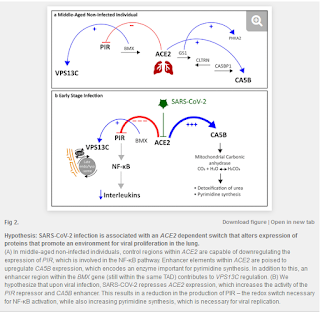Notes - week of 2020/11/2
Continuing with PON2... found a brand new article which is unfortunately paywalled:
https://pubmed.ncbi.nlm.nih.gov/33096292/
"Previously, we have demonstrated that β-estradiol-3-benzoate (EB) has a protective effect on the neurodegenerative experimental model of Parkinson's disease. The protective effect is through the induction of the expression of paraoxonase-2 (PON2) in the striatum. ... EB protective effect against MPP+ neurotoxicity is related to antioxidant effect of PON2, pro-inflammatory cytokines and GSHR but not to SOD2, catalase, GPX1 or GPX4."
Is the effect all due to estrogen, or is there some contribution from benzoate?
Maybe it's good I can't access the article, I have a lot of chores to do today ...
~
PON2 and bladder cancer:
https://pubmed.ncbi.nlm.nih.gov/28430636/
~
TMPRSS2 is up-regulated in rats treated with 6-hydroxydopamine (6-OHDA) to model PD [ PMID: 30713215 ].
~
The Potential Role of SARS-COV-2 in the Pathogenesis of Parkinson's Disease
https://pubmed.ncbi.nlm.nih.gov/33041985/
~
I had been thinking that there is probably more to the tendency to pneumonia in PD than just aspiration issues - that it had to do with immune dysregulation due to autonomic dysfunction (and that might also be true for spinal cord injury). However, there are articles on direct effects of alpha-synuclein pathology on immune function that I need to read.
~
copy/pasteof what I wrote on a forum (horrible formatting issues):
Here's a review just published last month:
ncbi.nlm.nih.gov/pmc/articl...
"The presence of respiratory symptoms in Parkinson's disease (PD) has
been known since the first description of the disease, even though the
prevalence and incidence of these disturbances are not well defined.
Several causes have been reported, comprising obstructive and
restrictive pulmonary disease and changes in the central ventilatory
control, and different pathogenetic mechanisms have been postulated
accordingly. In our review, we encompass the current knowledge about
respiratory abnormalities in PD, as well as the impact of
anti-Parkinsonian drugs as either risk or protective factors. A
description of putative pathogenetic mechanisms is also provided, and
possible treatments are discussed, focusing on the importance of
recognising and treating respiratory symptoms as a key manifestation of
the disease itself. A brief description of respiratory dysfunctions in
atypical Parkinsonism, especially α-synucleinopathies, is also provided."
It's a good review, but I don't think it goes far enough - I don't think the authors have fully explored all the possible mechanisms involved in respiratory dysfunction in PD. OTOH, I am gratified to see they drew parallels between NMLS and NMS:
" a significant reduction of anti-Parkinsonian drugs are risk factors for
the so-called neuroleptic malignant-like syndrome (NMLS), a rare but
severe clinical condition, resembling the well-known neuroleptic
malignant syndrome, characterised by hyperthermia, impaired
consciousness, autonomic dysfunction (e.g. respiratory failure) and elevated serum creatine kinase levels."
I suspect there are similar mechanisms involved in SUDPAR.
Some possible avenues for discussion and research:
- autonomic nervous system dysfunction leading to immune dysregulation which could cause chronic inflammation and increased vulnerability to infection
- direct effects of a-syn pathology on immune cell function
ncbi.nlm.nih.gov/pmc/articl...
- peripheral dopamine and its effects on the Na/K ATPase in lung epithelium
ncbi.nlm.nih.gov/pmc/articl...
- role of serotonergic system (it's implicated in sudden death in PD and MSA as well as SIDS, and is involved in ventilatory response generally)
pubmed.ncbi.nlm.nih.gov/194...
more speculative - just want to add this in case I forget about it - the role of paraoxonase in oxygen sensing in the periphery. There is evidence for AMPK's role in peripheral oxygen sensing with feedback to ventilatory control in brainstem; it might act through the AMPK/PON1 signalling axis (the latter statement is just speculation).
PON1 gene variants are associated with PD, and it is thought that these variants increase susceptibility to damage from environmental toxicants such as organophosphate pesticides which could initiate the disease process. I don't know if PON1 has a role in the ongoing PD disease process. I'm also very interested in PON2 as it is expressed much more highly in females than males; it is localized in mitochondria and is probably not directly involved in response to pesticide exposure; it interacts with coenzyme Q10.
There was a medical hypothesis-type article that suggests flavonoids for prevention of SUDPAR; I like the idea but have to admit that not much evidence was presented:
kenkyugroup.org/article/9/1...
High flavonoid foods like blueberries and acai unpregulate PON1 expression. Acai also increases erythropoietin production - perhaps by acting as a hormetic effector, mimicking hypoxia:
ncbi.nlm.nih.gov/pmc/articl...
Interesting sort of related - cetaceans (whales and dolphins) have evolved to lack PON1 activity. It may have something to do with adaptations for diving; type of dietary fat intake is another possibility:
https://youtu.be/S36zqLDrecI?t=200
~
A few days ago I forgot to log some stuff I had read about diosgenin (found in fenugreek) activating a cell surface vitamin D receptor, 1,25D3-MARRS.
https://www.nature.com/articles/srep03395.pdf?origin=ppub
http://www.oapublishinglondon.com/article/444
"The protein, which we have termed as the membrane-associated, rapid response steroid-binding (1,25D3-MARRS) receptor, is identical to ERp57/PDIA3."
https://www.ncbi.nlm.nih.gov/pmc/articles/PMC4810980/
~
https://www.ncbi.nlm.nih.gov/pmc/articles/PMC5391248/
"For example, it was thought for a half-century that PON1 would provide protection against parathion/paraoxon. The studies by Li et al. [19] showed that while PON1 hydrolyzed PO in vivo, the catalytic efficiency was too low to provide protection against exposure whereas, the catalytic efficiency of DZO [ diazoxon ] and CPO [ chlorpyrifos oxon ] hydrolysis was sufficient to protect against exposures to these two OPs. The clopidogrel and homocysteine thiolactone studies described above provide additional examples of the importance of assuming a physiological relevance of a given PON in metabolism of a specific compound without solid in vivo data to support the conclusion."

Comments
Post a Comment